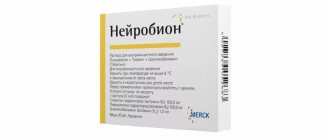Diclofenac-AKOS 25 mg/ml 3 ml ampoules 10 pcs. solution for intramuscular administration in Moscow
- Hypersensitivity to diclofenac or to any other drug from the group of non-steroidal anti-inflammatory drugs (NSAIDs), as well as to any of the excipients of the drug; erosive and ulcerative lesions of the gastrointestinal tract (in the acute phase), bleeding from the gastrointestinal tract, inflammatory bowel diseases (nonspecific ulcerative colitis, Crohn's disease); severe liver failure, liver disease in the acute period;
- severe renal failure (creatinine clearance less than 30 ml/min), hyperkalemia;
- complete or incomplete acetylsalicylic acid intolerance syndrome (rhinosinusitis, urticaria, nasal polyps, bronchial asthma that occurs when taking acetylsalicylic acid or other NSAIDs);
- hematopoietic disorders, hemostasis disorders (including hemophilia);
- pregnancy, breastfeeding period,
- children under 18 years of age;
- period after coronary artery bypass surgery;
- with an increased risk of arterial thrombosis and thromboembolism;
- chronic heart failure, functional class II-IV according to the NYHA classification;
- clinically confirmed coronary heart disease;
- diseases of peripheral arteries and cerebral vessels; uncontrolled arterial hypertension.
With caution:
coronary heart disease, cerebrovascular diseases, congestive heart failure, arterial hypertension, significant decrease in circulating blood volume (including after major surgery), edema syndrome, peripheral arterial disease, dyslipidemia, diabetes mellitus, anemia, bronchial asthma , renal failure (creatinine clearance less than 60 ml/min), alcoholism, erosive and ulcerative diseases of the gastrointestinal tract without exacerbation, history of liver disease, diverticulitis, condition after extensive surgery, inducible porphyria, old age, smoking, severe somatic diseases , systemic connective tissue diseases, long-term use of nonsteroidal anti-inflammatory drugs, simultaneous use of glucocorticosteroids, anticoagulants, antiplatelet agents, selective serotonin reuptake inhibitors, hyperlipidemia, the presence of
Helicobacter pylori infection.
Diclofenac-acos 1% 30g ointment for external use
pharmachologic effect
Non-steroidal anti-inflammatory drug.
Composition and release form Diclofenac-akos 1% 30g ointment for external use
Ointment - 100 g:
- Active ingredient: diclofenac sodium – 1.0 g;
- Excipients: dimethyl sulfoxide (dimexide), macrogol 400 (polyethylene glycol 400), macrogol 4000 (polyethylene glycol 4000), propylene glycol, methyl parahydroxybenzoate (methylparaben, nipagin), propyl parahydroxybenzoate (propylparaben, nipazole).
30 g in aluminum tubes. Each tube with instructions for use is placed in a cardboard pack.
Description of the dosage form
The ointment is white or almost white in color, with a weak specific odor.
Directions for use and doses
Externally.
For adults and children over 12 years of age, the ointment is applied to the skin 2 times a day (every 12 hours, preferably in the morning and evening), in a dose of 2-4 g. Apply a thin layer to the skin above the inflammation and rub in lightly.
The maximum daily dose of ointment should not exceed 8 g.
The course of treatment is no more than 14 days. If there is no effect from using the drug after 7 days, you should consult a doctor.
If your hands are not the area where pain is localized, then after applying the ointment they should be washed.
Use in minimally effective doses for a minimally short course.
Pharmacodynamics
The active component of the drug diclofenac is a nonsteroidal anti-inflammatory drug (NSAID) with pronounced analgesic and anti-inflammatory properties. Indiscriminately inhibiting cyclooxygenase types 1 and 2, it disrupts the metabolism of arachidonic acid and the synthesis of prostaglandins, which are the main link in the development of inflammation. Diclofenac is used to eliminate pain and inflammation in joints, muscles and ligaments of traumatic or rheumatic origin, helping to reduce pain and swelling associated with the inflammatory process, increasing joint mobility.
Pharmacokinetics
When applied externally, diclofenac penetrates well through the skin, mainly concentrating in the site of inflammation and synovial fluid. The amount of diclofenac that is absorbed through the skin is proportional to the time of contact of the ointment with the skin and the area of its application, depending on the total dose of the drug and the degree of skin hydration. With the recommended method of applying the drug, no more than 6% of diclofenac is absorbed. The use of an occlusive dressing for 10 hours leads to a 3-fold increase in the resorption of diclofenac.
Indications for use Diclofenac-akos 1% 30g ointment for external use
- back pain due to inflammatory and degenerative diseases of the spine (osteoarthrosis, radiculitis, lumbago, sciatica);
- joint pain (finger joints, knee joints, etc.) due to osteoarthritis;
- muscle pain;
- inflammation and swelling of soft tissues and joints due to injuries and rheumatic diseases;
- pain and swelling associated with diseases of muscles and joints (lumbago, sciatica, neuralgia, myalgia, tendinitis);
- degenerative diseases of the musculoskeletal system (deforming osteoarthritis, osteochondrosis).
Intended for symptomatic therapy, reducing pain and inflammation at the time of use, does not affect the progression of the disease.
Contraindications
Hypersensitivity to diclofenac.
Complete or incomplete combination of bronchial asthma, recurrent polyposis of the nose and paranasal sinuses, and intolerance to acetylsalicylic acid or other NSAIDs (including a history).
Pregnancy (III trimester), breastfeeding period, childhood (up to 12 years).
Violation of the integrity of the skin at the intended site of application.
Carefully
Hepatic porphyria (exacerbation), erosive and ulcerative lesions of the gastrointestinal tract, severe dysfunction of the liver and kidneys, chronic heart failure, bleeding disorders (including hemophilia, prolongation of bleeding time, bleeding tendency), old age, pregnancy I and II trimester.
Application of Diclofenac-akos 1% 30g ointment for external use during pregnancy and lactation
The drug should not be used in the third trimester of pregnancy.
Due to the lack of data on the penetration of the drug into breast milk, its use during breastfeeding is not recommended. If you still need to use the drug, then you should not apply it to the mammary glands or large surfaces of the skin and do not use it for a long time.
Use in the first and second trimesters is possible only after consultation with a doctor if the expected benefit to the mother outweighs the potential risk to the fetus.
special instructions
Apply externally only. The ointment can only be applied to intact areas of the skin. After applying the ointment, do not apply an occlusive dressing. Before use, patients with gastric and duodenal ulcers, impaired liver, kidney or hematopoietic function, as well as concomitant use of other NSAIDs, should consult a doctor. When using the drug together with other dosage forms of diclofenac, the maximum daily dose should be taken into account.
With long-term use and/or application to large surfaces, systemic side effects may develop due to the resorptive effect. Avoid contact of the drug with the eyes, mucous membranes or open wounds.
Impact on the ability to drive vehicles and operate machinery
The drug does not affect the ability to drive vehicles and other machinery.
Overdose
Due to the low systemic absorption when applying the ointment, an overdose is unlikely.
In case of accidental ingestion, systemic adverse reactions may develop. Symptoms: nausea and vomiting.
Treatment: gastric lavage, induction of vomiting, activated charcoal, forced diuresis, symptomatic therapy.
Hemodialysis is not effective due to the high degree of binding of diclofenac to plasma proteins (about 99%).
Side effects Diclofenac-akos 1% 30g ointment for external use
The incidence of side effects is classified according to the recommendations of the World Health Organization: very often - ≥1/10; often – from ≥1/100 to
Local reactions: infrequently - exudative erythema multiforme (including Stevens-Johnson syndrome), eczema, very rarely contact dermatitis (itching, hyperemia, swelling of the treated skin area, papular-vesicular rashes, peeling).
When applying the ointment to large surfaces of the skin over a long period of time, systemic side effects of diclofenac may develop. Systemic reactions: rarely - generalized skin rash, allergic reactions (urticaria, angioedema, bronchospastic reactions), rarely - photosensitivity, very rarely - anaphylactic reactions (including shock).
Drug interactions
The use of the drug with other NSAIDs is not recommended.
Diclofenac may enhance the effect of drugs that cause photosensitivity. Clinically significant interactions with other drugs have not been described.
Diclofenac-akos solution for injection 25 mg/ml 3 ml amp. 5 pieces
To reduce the risk of adverse events, the minimum effective dose should be used in a short course. Often - 1-10%; sometimes – 0.1-1%; rarely - 0.01-0.1%; very rarely - less than 0.001%, including isolated cases. From the digestive system: - often - epigastric pain, nausea, vomiting, diarrhea, dyspepsia, flatulence, anorexia, increased aminotransferase activity; - rarely - gastritis, proctitis, bleeding from the gastrointestinal tract (vomiting with blood, melena, diarrhea mixed with blood), ulcers of the gastrointestinal tract (with or without bleeding or perforation), hepatitis, jaundice, impaired liver function; - very rarely - stomatitis, glossitis, damage to the esophagus, diaphragm-like intestinal strictures (nonspecific hemorrhagic colitis, exacerbation of ulcerative colitis or Crohn's disease), constipation, pancreatitis, fulminant hepatitis.
From the nervous system: - often - headache, dizziness; - rarely - drowsiness; - very rarely - sensory disturbance, incl. paresthesia, memory disorders, tremor, convulsions, anxiety, cerebrovascular disorders, aseptic meningitis, disorientation, depression, insomnia, nightmares, irritability, mental disorders.
From the senses: - often - vertigo; - very rarely - visual impairment (blurred vision, diplopia), hearing impairment, tinnitus, impaired sense of taste.
From the urinary system: - very rarely - acute renal failure, hematuria, proteinuria, interstitial nephritis, nephrotic syndrome, papillary necrosis.
From the hematopoietic organs: - very rarely - thrombocytopenia, leukopenia, hemolytic and aplastic anemia, agranulocytosis.
Allergic reactions: - anaphylactic/anaphylactoid reactions, including a pronounced decrease in blood pressure and shock; - very rarely - angioedema (including the face).
From the cardiovascular system: - very rarely - palpitations, chest pain, increased blood pressure, vasculitis, heart failure, myocardial infarction. From the respiratory system: - rarely - bronchial asthma (including shortness of breath); - very rarely - pneumonitis.
From the skin: - often - skin rash; - rarely - urticaria; - very rarely - bullous rashes, eczema, incl. multiforme and Stevens-Johnson syndrome, Lyell's syndrome, exfoliative dermatitis, itching, hair loss, photosensitivity, purpura, incl. allergic.
Local reactions with intramuscular injection: - burning, infiltration, aseptic necrosis, necrosis of adipose tissue.

